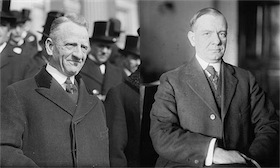The Interest Rate Caps of Yore

Glass and Steagall, regulatin'
I liked John Cassidy's article on Wall Street as parasitical I great deal, but I thought one line at the end might end up misleading people:
In 1940, a former Wall Street trader named Fred Schwed, Jr., wrote a charming little book titled "Where Are the Customers' Yachts?," in which he noted that many members of the public believed that Wall Street was inhabited primarily by "crooks and scoundrels, and very clever ones at that; that they sell for millions what they know is worthless; in short, that they are villains." It was an extreme view, but public antagonism toward bankers and other financiers kept them in check for forty years. Economic historians refer to a period of "financial repression," during which regulators and policymakers, reflecting public suspicion of Wall Street, restrained the growth of the banking sector. They placed limits on interest rates, prohibited deposit-taking institutions from issuing securities, and, by preventing financial institutions from merging with one another, kept most of them relatively small. During this period, major financial crises were conspicuously absent, while capital investment, productivity, and wages grew at rates that lifted tens of millions of working Americans into the middle class.
Since the early nineteen-eighties, by contrast, financial blowups have proliferated and living standards have stagnated. Is this coincidence? For a long time, economists and policymakers have accepted the financial industry's appraisal of its own worth, ignoring the market failures and other pathologies that plague it. Even after all that has happened, there is a tendency in Congress and the White House to defer to Wall Street because what happens there, befuddling as it may be to outsiders, is essential to the country's prosperity. Finally, dissidents like Paul Woolley are questioning this narrative. "There was a presumption that financial innovation is socially valuable," Woolley said to me. "The first thing I discovered was that it wasn't backed by any empirical evidence. There's almost none."
It's important to understand the role of the regulation capping interest rates in this scheme. That wasn't a rule about "repressing" evil banksters. It was a rule about setting bankers up with a cozy cartel. The way post-deregulation banking works is that if banks compete to get customers' funds by offering generous interest rates. And since interest on a checking or savings account is basically a commodity product, the price competition tends to lead to the profits all being competed away. Back in the days of the regulatory cap on interest rates, things were different and old-school depository institutions basically had guaranteed profits. The ban on interstate banking had a similar effect—annoying to consumers, but convenient for restricting the level of competition.
The point Gary Gorton makes in his excellent book Slapped by the Invisible Hand is that it's hard to separate out the good and the bad in the process of unwinding this arrangement. The old days of guaranteed profits posed real problems for customers. You can be as skeptical of "financial innovation" as you like and still recognize real value in such innovations as savings accounts with positive real interest rates, branches that are open later than 3PM and sometimes even on Saturday, and other basic efforts to act like real businesses in a competitive marketplace that need to sell products to customers.
But once you bring competition into this field, you largely take the profit out of it. The reason banking used to be dominated by boring "take the deposit, loan the money" business models is that those models were profitable. Deregulated, more competition came into play, consumers got a lot of benefits, but the real money moved elsewhere ("shadow banking") and the industry naturally became dominated less by people who were interested in leaving work early ("bankers' hours") than by people who were interested in dreaming up ways to get rich.


Matthew Yglesias's Blog
- Matthew Yglesias's profile
- 72 followers



